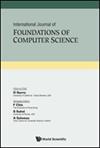On the Super (Edge)-Connectivity of Generalized Johnson Graphs
IF 0.6
4区 计算机科学
Q4 COMPUTER SCIENCE, THEORY & METHODS
International Journal of Foundations of Computer Science
Pub Date : 2023-09-27
DOI:10.1142/s012905412350017x
引用次数: 0
Abstract
Let [Formula: see text], [Formula: see text] and [Formula: see text] be non-negative integers. The generalized Johnson graph [Formula: see text] is the graph whose vertices are the [Formula: see text]-subsets of the set [Formula: see text], and two vertices are adjacent if and only if they intersect with [Formula: see text] elements. Special cases of generalized Johnson graph include the Kneser graph [Formula: see text] and the Johnson graph [Formula: see text]. These graphs play an important role in coding theory, Ramsey theory, combinatorial geometry and hypergraphs theory. In this paper, we discuss the connectivity properties of the Kneser graph [Formula: see text] and [Formula: see text] by their symmetric properties. Specifically, with the help of some properties of vertex/edge-transitive graphs we prove that [Formula: see text] [Formula: see text] and [Formula: see text] [Formula: see text] are super restricted edge-connected. Besides, we obtain the exact value of the restricted edge-connectivity and the cyclic edge-connectivity of the Kneser graph [Formula: see text] [Formula: see text] and [Formula: see text] [Formula: see text], and further show that the Kneser graph [Formula: see text] [Formula: see text] is super vertex-connected and super cyclically edge-connected.关于广义Johnson图的超(边)连通性
设[公式:见文]、[公式:见文]、[公式:见文]为非负整数。广义Johnson图[公式:见文]是其顶点为[公式:见文]集合[公式:见文]的子集[公式:见文]的图,且两个顶点相邻当且仅当它们与[公式:见文]元素相交。广义Johnson图的特殊情况包括Kneser图[公式:见文]和Johnson图[公式:见文]。这些图在编码理论、拉姆齐理论、组合几何和超图理论中起着重要的作用。本文根据Kneser图[公式:见文]和[公式:见文]的对称性质,讨论了它们的连通性。具体来说,利用点/边传递图的一些性质,证明了[公式:见文][公式:见文]和[公式:见文][公式:见文]是超受限边连通的。此外,我们得到了Kneser图[公式:见文][公式:见文]和[公式:见文][公式:见文]的限制边连通性和循环边连通性的精确值,并进一步证明了Kneser图[公式:见文][公式:见文]是超顶点连通和超循环边连通。
本文章由计算机程序翻译,如有差异,请以英文原文为准。
求助全文
约1分钟内获得全文
求助全文
来源期刊

International Journal of Foundations of Computer Science
工程技术-计算机:理论方法
CiteScore
1.60
自引率
12.50%
发文量
63
审稿时长
3 months
期刊介绍:
The International Journal of Foundations of Computer Science is a bimonthly journal that publishes articles which contribute new theoretical results in all areas of the foundations of computer science. The theoretical and mathematical aspects covered include:
- Algebraic theory of computing and formal systems
- Algorithm and system implementation issues
- Approximation, probabilistic, and randomized algorithms
- Automata and formal languages
- Automated deduction
- Combinatorics and graph theory
- Complexity theory
- Computational biology and bioinformatics
- Cryptography
- Database theory
- Data structures
- Design and analysis of algorithms
- DNA computing
- Foundations of computer security
- Foundations of high-performance computing
 求助内容:
求助内容: 应助结果提醒方式:
应助结果提醒方式:


